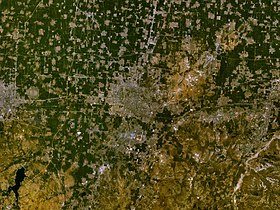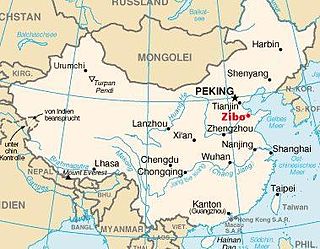Zibo
| Zibó Shì 淄博 市 Zibo |
|
|---|---|
 Satellite photo |
|
| Coordinates | 36 ° 47 ' N , 118 ° 3' E |
 Location Zibos in China |
|
| Basic data | |
| Country | People's Republic of China |
| region | East china |
| province | Shandong |
| ISO 3166-2 | CN-SD |
| status | District-free city |
| structure | 5 city districts, 3 districts |
| height | 1108 m |
| surface | 2972 km² |
| Metropolitan area | 5938 km² |
| Residents | 3,129,228 (2010) |
| Metropolitan area | 4,530,597 (2010) |
| density | 1,052.9 Ew. / km² |
| Metropolitan area | 763 Ew. / km² |
| Post Code | 255100 |
| Telephone code | +86 (0) 533 |
| Time zone | China Standard Time (CST) UTC +8 |
| License Plate | 鲁 C |
| Website | www.zibo.gov.cn |
| politics | |
| mayor | Zhou Qingli |
Zibo ( Chinese 淄博 市 , Pinyin Zibó Shì ) is a district-free city in the Chinese province of Shandong . The administrative area of Zibo has an area of 5,938 km² and around 4.68 million inhabitants (mid-2016). The population density is almost 694 inhabitants / km². 2.2 million people live in the actual urban settlement area of Zibo (2010 census). Zibo lies on the Yellow River at 37 ° 13 'N. Br. And 118 ° 04' E. L.
geography
Administrative structure
At the district level, Zibo is made up of five city districts and three districts. These are:
- Zhangdian district (张店 区), 360 km², 690,000 inhabitants, center, seat of the city government;
- Zichuan District (淄川 区), 999 km², 670,000 inhabitants;
- Boshan District (博山区), 682 km², 470,000 inhabitants;
- City district Linzi (临淄 区), 668 km², 590,000 inhabitants;
- Zhoucun District (周村 区), 263 km², 310,000 inhabitants;
- Huantai district (桓台 县), 499 km², 480,000 inhabitants, main town: Suozhen municipality (索 镇镇);
- Gaoqing district (高 青县), 830 km², 360,000 inhabitants, main town: Tianzhen municipality (田镇 镇);
- Yiyuan County (沂源县), 1,637 km², 550,000 inhabitants, main town: Nanma Municipality (南 麻 镇).
| map |
|---|
history
Linzi was at the time of the spring and autumn annals and the time of the Warring States , from 384 BC. BC to 221 BC BC, the capital of the state of Qi (齊; pinyin : Qí).
The area of the then city of Zichuan was the home of the poet Pu Songling (1640–1715), who became famous primarily for his Strange Tales from Liao Zhai ( Liao Zhai Zhi Yi ).
In 1937 the then still independent cities of Zichuan, Boshan and Zhangdian were captured by Japan in the second Sino-Japanese War (1937–1945) , and extensive industrialization of the region began under Japanese rule .
The city of Zibo was created in 1955 by the merger of the cities of Zi chuan and Bo shan, whose names were merged to Zibo . A special area with this name was created as early as August 1945 . In 1961, the Boshan Administrative Center was relocated to Zhangdian.
Between 1953 and 1958 the population tripled from 259,000 to 875,000 and in 1963 Zibo replaced Qingdao as the largest industrial city in Shandong.
politics
Town twinning
Zibo has twinned cities with eleven cities:
| city | country | since |
|---|---|---|
| Batumi |
|
1998 |
| Bergamo Province |
|
2007 |
| Bratsk |
|
2007 |
| Erie |
|
1985 |
| Gwangju |
|
2003 |
| Kamo |
|
1993 |
| La Roche-sur-Yon |
|
1991 |
| Mandaue City |
|
2002 |
| Newcastle |
|
2002 |
| São José dos Pinhais |
|
2009 |
| Veliky Novgorod |
|
1995 |
economy
Zibo is traditionally shaped by industry, and the city was considered the center of silk weaving from an early age . Today Zibo is one of the 50 economically strongest cities in China. The city is located on a large coal deposit, which means that the industrial focus is on coal and petrochemicals , as well as ceramics and mechanical engineering . Zibo primarily unites heavy industry . Light industry and food production are mainly found in Zhangdian.
According to a study from 2014, Zibo generated a gross domestic product of 100.3 billion US dollars in purchasing power parity . In the ranking of the economically strongest metropolitan regions worldwide, it took 134th place. The GDP per capita is $ 21,681 (PFC). The GDP per capita grew by an average of 12.8% annually from 2000 to 2014.
Attractions
In the north of Linzi are the ruins of the old capital of Qi , the excavated artifacts have been on display in the newly opened Qi Culture Museum ( 齐 文化 博物院 ) since 2016 . Another museum is dedicated to the Zichuan-born writer Pu Songling. Boshan, situated in a mountainous valley, is known for the beauty of its wooded slopes. In the Yuanshan National Forest in the southwest of Boashan there are some remains of the Great Wall of Qi State .
sons and daughters of the town
Web links
Individual evidence
- ↑ Shandong (China): Prefecture Level, Cities & Counties - Population Statistics, Maps, Graphics, Weather and Web Information. Retrieved January 17, 2018 .
- ↑ a b Zibo. In: Encyclopædia Britannica . Retrieved August 1, 2017 .
- ↑ 淄博 市政府 信息 公开 - 淄博 市 国际 友好城市 一览表. Retrieved August 28, 2015 .
- ^ Alan Berube, Jesus Leal Trujillo, Tao Ran, and Joseph Parilla: Global Metro Monitor . In: Brookings . January 22, 2015 ( brookings.edu [accessed July 19, 2018]).

